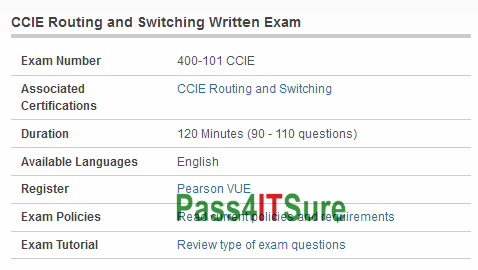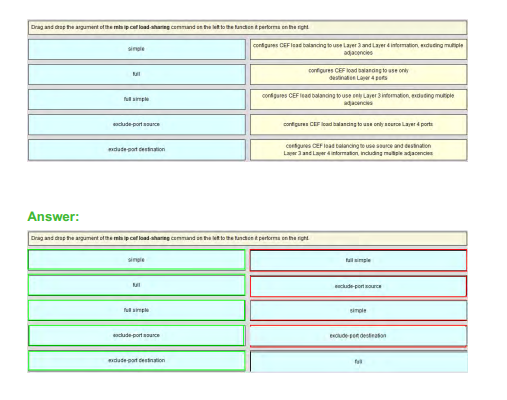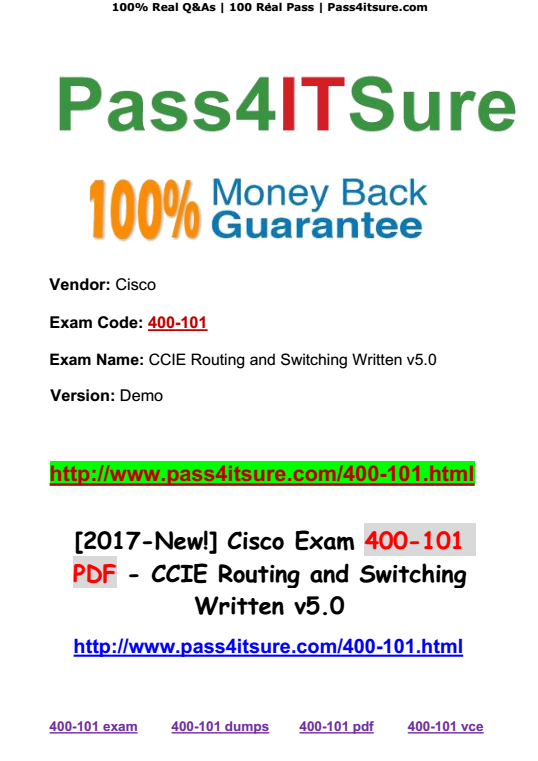How you can prepare Cisco 400-101 dumps exam in just one week? The CCIE Routing and Switching Written Exam (400-101 CCIE Routing and Switching) exam is a 120 Minutes (90 – 110 questions) assessment in pass4itsure that is associated with CCIE Routing and Switching certification. Latest upload Cisco 400-101 dumps pdf CCIE Routing and Switching exam questions and answers with low price Youtube training.”CCIE Routing and Switching Written Exam” is the exam name of Pass4itsure Cisco 400-101 dumps test which designed to help candidates prepare for and pass the Cisco 400-101 exam. Cisco Certified Internetwork Expert Routing and Switching certification validate your ability to Apply Network Principles, Apply Layer 3 Technologies, and Apply Network Principles. These skills allow you to simplify and standardize the most complex daily activities running your team increase your credibility and value https://www.pass4itsure.com/400-101.html dumps within the organization.
[100% Valid Cisco 400-101 Dumps Questions From Google Drive]: https://drive.google.com/open?id=0BwxjZr-ZDwwWczJDVzl1SUJLWms
[100% Valid Cisco 400-151 Dumps Questions From Google Drive]: https://drive.google.com/open?id=0BwxjZr-ZDwwWNkViTVpuUWl4SGs
Cisco 400-101 Dumps Certification Audience: Cisco Certified Internetwork Expert Routing and Switching Certification will forward your career towards
- network engineer
- support engineer
- network technician

Pass4itsure Free Cisco 400-101 Dumps Exam Questions and Answers:
Question No : 6 – (Topic 1) Which statement describes the purpose of the Payload Type field in the RTP header?
A. It identifies the signaling protocol.
B. It identifies the codec.
C. It identifies the port numbers for RTP.
D. It identifies the port numbers for RTCP.
400-101 exam Answer: B
Explanation:
PT, Payload Type. 7 bits: Identifies the format of the RTP payload and determines its interpretation by the application. A profile specifies a default static mapping of payload type codes to payload formats. Additional payload type codes may be defined dynamically through non-RTP means. An RTP sender emits a single RTP payload type at any given time; this field is not intended for multiplexing separate media streams. A full list of codecs and their payload type values can be found at the link below:
Question No : 7 – (Topic 1) How many hash buckets does Cisco Express Forwarding use for load balancing?
A. 8
B. 16
C. 24
D. 32
Answer: B
Explanation:
In order to understand how the load balance takes place, you must first see how the tables relate. The Cisco Express Forwarding table points to 16 hash buckets (load share table), which point to the adjacency table for parallel paths. Each packet to be switched is broken up into the source and destination address pair and checked against the loadshare table.
Question No : 8 – (Topic 1) Which statement is true regarding the UDP checksum?
A. It is used for congestion control.
B. It cannot be all zeros.
C. It is used by some Internet worms to hide their propagation.
D. It is computed based on the IP pseudo-header.
400-101 dumps Answer: D
Explanation:
The method used to compute the checksum is defined in RFC 768: “Checksum is the 16-bit one’s complement of the one’s complement sum of a pseudo header of information from the IP header, the UDP header, and the data, padded with zero octets at the end (if necessary) to make a multiple of two octets.” In other words, all 16-bit words are summed using one’s complement arithmetic. Add the 16-bit values up. Each time a carry-out (17th bit) is produced, swing that bit around and add it back into the least significant bit. The sum is then one’s complemented to yield the value of the UDP checksum field. If the checksum calculation results in the value zero (all 16 bits 0) it should be sent as the one’s complement (all 1s).
Question No : 9 – (Topic 1)
Which two Cisco Express Forwarding tables are located in the data plane? (Choose two.)
A. the forwarding information base
B. the label forwarding information base
C. the IP routing table
D. the label information table
E. the adjacency table
Answer: A,B
Explanation:
The control plane runs protocols such as OSPF, BGP, STP, LDP. These protocols are needed so that routers and switches know how to forward packets and frames. The data plane is where the actual forwarding takes place. The data plane is populated based on the protocols running in the control plane. The Forwarding Information Base (FIB) is used for IP traffic and the Label FIB is used for MPLS.
Question No : 10 – (Topic 1) Which two mechanisms can be used to eliminate Cisco Express Forwarding polarization? (Choose two.)
A. alternating cost links
B. the unique-ID/universal-ID algorithm
C. Cisco Express Forwarding antipolarization
D. different hashing inputs at each layer of the network
400-101 pdf Answer: B,D
Explanation:
This document describes how Cisco Express Forwarding (CEF) polarization can cause suboptimal use of redundant paths to a destination network. CEF polarization is the effect when a hash algorithm chooses a particular path and the redundant paths remain completely unused. How to Avoid CEF Polarization Alternate between default (SIP and DIP) and full (SIP + DIP + Layer4 ports) hashing inputs configuration at each layer of the network. Alternate between an even and odd number of ECMP links at each layer of the network.The CEF load-balancing does not depend on how the protocol routes are
inserted in the routing table. Therefore, the OSPF routes exhibit the same behavior as EIGRP. In a hierarchical network where there are several routers that perform load-sharing in a row, they all use same algorithm to load-share. The hash algorithm load-balances this way by default:
1: 1
2: 7-8
3: 1-1-1
4: 1-1-1-2
5: 1-1-1-1-1
6: 1-2-2-2-2-2
7: 1-1-1-1-1-1-1
8: 1-1-1-2-2-2-2-2
The number before the colon represents the number of equal-cost paths. The number after the colon represents the proportion of traffic which is forwarded per path.
This means that:
For two equal cost paths, load-sharing is 46.666%-53.333%, not 50%-50%. For three equal cost paths, load-sharing is 33.33%-33.33%-33.33% (as expected). For four equal cost paths, load-sharing is 20%-20%-20%-40% and not 25%-25%-
25%-25%. This illustrates that, when there is even number of ECMP links, the traffic is not load balanced. Cisco IOS introduced a concept called unique-ID/universal-ID which helps avoid CEF polarization. This algorithm, called the universal algorithm (the default in current Cisco IOS versions), adds a 32-bit router-specific value to the hash function (called the universal ID – this is a randomly generated value at the time of the switch boot up that can can be manually controlled). This seeds the hash function on each router with a unique ID, which ensures that the same source/destination pair hash into a different value on different routers along the path. This process provides a better network-wide load-sharing and circumvents the polarization issue. This unique -ID concept does not work for an even number of equal-cost paths due to a hardware limitation, but it works perfectly for an odd number of equal-cost paths. In order to overcome this problem, Cisco IOS adds one link to the hardware adjacency table when there is an even number of equal cost paths in order to make the system believe that there is an odd number of equal-cost links.
Question No : 11 DRAG DROP – (Topic 1) Drag and drop the argument of the mls ip cef load-sharing command on the left to the function it performs on the right.

Question No : 12. Following the installation of the Symposium Express 3.0 server software, what steps must the field engineer take to install PEPs on the Symposium Express server?
A. Log on to the NT server as NGenDist, shutdown all applications, and proceed with the PEP installation.
B. Log on to the NT server as Administrator, shutdown screen savers, and proceed with the PEP installation.
C. Log on to the NT server as NGenSys, shutdown all applications, including screen savers and proceed with the PEP installation.
D. Log on to the NT server as NGenDist, shutdown all applications, including screen savers and proceed with the PEP installation.
400-101 vce Answer: C
Question No : 13. Before you perform software upgrade from these versions of Symposium Web Client (04.00.037.00 to 04.02.011.04 inclusive) to a version downloaded from the Nortel web site, what must you do?
A. Ensure that Active Directory is installed.
B. Ensure Sybase is installed in the Default directory.
C. Make sure that SP5 or SP6a is installed before the upgrade.
D. Download the Microsoft Windows Installer package “CRTEmplates.msi”.
Answer: D
Question No : 14. A field engineer is performing an upgrade from Symposium Call Center Server 1.5 to 4.0 on a PVI platform. The steps to restoring the database have been completed. An error during the database initialization states: “could not create database”. Given that a successful integrity check on the database has been run, what steps should the field engineer perform next?
A. Key the database in by hand.
B. Fdisk and format all hard drives, perform the procedure again from the beginning.
C. Uninstall Symposium Call Center Server, and start the procedure over from that point.
D. Check the platform recovery disk for database segmentation and contact Nortel Networks support if segmentation is found.
400-101 exam Answer: D
Question No : 15. A field engineer at a customer’s site is preparing for a Symposium Call Center Server 1.5 to 4.0 migration. In performing the pre-upgrade checks it is discovered that the disk partitions on the 1.5 server are primary partitions. What action should the field engineer take next?
A. The migration can proceed, making note of the problem. The partitions will be created correctly on the new 4.0 server.
B. Schedule time with the customer to convert the drives from primary to extended partitions using individual full backups for each drive as time allows.
C. Perform a database backup on the 1.5 server. Use Disk Administrator to delete the partitions and re-create them as extended partitions. Perform a database restore.
D. Perform a full backup on the 1.5 server. Fdisk and format the 1.5 server drives. Perform the full restore procedure, ensuring the database drives are partitioned as extended partitions.
Answer:A
Question No : 16. A customer is using Symposium Web Client to manage and configure a call center and its users. Active Directory and other files are used to store user data. When restoring data in the event of a system failure in this scenario, which statement is TRUE regarding where the Active Directory can be restored?
A. Onto a remote directory of a network computer
B. Only onto an application server other than the original server
C. Only onto the same application server where the backup was created
D. Onto the same application server where the backup was created or onto a different application server
400-101 dumps Answer: D
Question No : 17. Once the SMI workbench client software has been successfully installed on the client PC, what are the steps to connect the client PC with the Symposium Call Center Server 4.0?
A. Select Start Menu, choose programs, SMI workbench, double click add system, enter the clan IP address.
B. Select Start Menu, choose programs, double click add system, the add SMI System dialog box appears, click finish.
C. Select Start Menu, choose programs, SMI workbench, double click add system, the add SMI System dialog box appears, enter the computer name.
D. Select Start Menu, choose programs, SMI workbench, double click add system, the add SMI System dialog box appears, enter computer name or clan IP.
Answer: D
Question No : 18. A customer has decided not to configure DNS service on the Web Client Win 2000 Server. Which files need to be manually updated on the Web Client 4.0 server to replace this functionality?
A. config.sys
B. lmhost table
C. command.com
D. autoexec.bat
400-101 pdf Answer: B
Question No : 19. The field engineer is preparing to use the “import configuration data” wizard to add to the Symposium Express Call Center 3.0 database automatically. What information is brought into the server using the “import configuration data” wizard?
A. User, skillset, agent to skillset assignment, and call presentation classes.
B. User, skillset, agent to supervisor assignment, and call presentation classes.
C. Agent only users, skillset, agent to skillset assignment, and call presentation classes.
D. Supervisor only users, skillset, agent to skillset assignment, and call presentation classes.
Answer:A
Question No : 20. A field engineer is preparing a new Symposium Call Center Server 4.0 installation. What must be configured to enable the server to communicate with all required components?
A. TCP/IP on the PBX switch
B. TCP/IP on the TAPI Server
C. TCP/IP on the ELAN, CLAN NIC and RAS
D. NetBios on the Symposium Call Center Server
400-101 vce Answer: C
Question No : 21. When upgrading a SECC Client you get an error When upgrading a SECC Client you get an error annot overwrite C:\Nortel\Iccm\En\crp32.dll.?What must be done previous to the upgrade to resolve this issue ?
A. Remove all Client peps and reboot the Server.
B. Make sure that SP5 or SP6a is installed before the upgrade.
C. Ensure Report Listener is closed down before upgrading the client.
D. This error is intermittent and if it occurs it can be cancelled and ignored.
Answer: C

All references in Pass4itsure are compiled by the professional experience and experts who are familiar with the last exams and testing center for years. So Cisco 400-101 dumps CCIE R&S Written Exam Exam Practice Questions product could cover 100% topic areas and ensure good results for professionals. “CCIE Routing and Switching Written Exam”, also known as 400-101 exam, is a Cisco certification which covers all the knowledge points of the real Cisco exam. Pass4itsure Cisco 400-101 dumps exam questions answers are updated (828 Q&As) are verified by experts. The associated certifications of https://www.pass4itsure.com/400-101.html dumps is CCIE Routing and Switching.